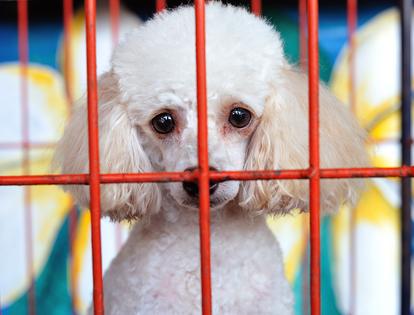My Pet World: Kennel anxiety in dogs, feeding tips for birds, and litter box blues in cats
Dear Cathy,
Our four-year-old Havapoo has been kenneled for most nights since a pup. She was great until about a year ago when she suddenly resisted getting into the kennel. It got better for a while, then worse again. Once in, she claws at the kennel door and whines. We tried a different kennel, but it did not help.
She has developed a fear of bees and flies since having a bad encounter with a bee's nest, so maybe she fears confinement as she can't escape the presence of a fly or something. We want her to sleep in a kennel as our daughter and other dog sitters don't want her sleeping on their beds with them. We are at a loss.
— Mike, Corvallis, Oregon
Dear Mike,
Since behavior changes can be related to health problems, please ensure she gets a clean bill of health from the vet before addressing the behavior.
Given her history with bees and her recent fear of confinement, you may be right about her needing an escape route or feeling that her kennel is too confining. I recommend trying a much larger kennel and paying attention to its location to see if something in the environment is scaring her. Cover the kennel on the top and three sides with a blanket if it is not covered. If it is covered, remove the cover. Keep trying different things to see how she responds.
Next consider giving her over-the-counter anxiety supplements to help her relax. Canine pheromones (via spray, collar, or plug-in) and anxiety clothing can help reduce any anxiousness.
Re-train her to enjoy her kennel again by leaving the door open during the day and placing her favorite toys, treats, or meals inside to help her associate the space with positive experiences. You can also add a cozy bed or blanket with familiar scents.
At night, leave the kennel door open to see if she stays inside voluntarily. (Close your daughter’s bedroom door or put a baby gate across the bedroom’s entry, so your dog doesn’t go into her room.) Giving her the choice to enter the kennel on her own can help ease any feelings of being pressured. Please also give her a 20-minute walk before bedtime to help tire her.
If she continues to freak out over the kennel, then it's time to consider alternative confinement options. A large, open-top playpen or a dog-proofed bathroom with a baby gate across the entry might give her more space without making her feel confined.
It's hard to know why she suddenly got scared of the kennel. It could be illness, age, or her experience with the bees. Sometimes, we just never know. However, if you try these things in tandem, you will provide a more holistic approach to resolving this issue.
Dear Cathy,
How much parrot food do I put in her food dish? Half full? Full? How often do I change this? I’m confused. I do change her water every day.
— Bruce, Flushing, New York
Dear Bruce,
You want to provide enough food to meet her daily needs, but not so much that she leaves it uneaten, and it goes stale. So, aim for a half-full food dish, and refill as needed. Parrots, and other birds, can be picky about their food. Stale food sitting in the dish will not be appealing to them. Offer them fresh food and water daily to encourage better eating habits, and add fruits, vegetables, and healthy treats to keep her diet varied, balanced, and interesting.
Dear Cathy,
My friend’s nine-year-old female cat steps into her litter box and poops and urinates right by the opening. She bought a taller box, but urine still goes over the opening. Don’t cats normally turn around when they go into the litter box? I think she may have arthritis and can’t squat anymore. Any thoughts?
— Eleanore, Bohemia New York
Dear Eleanore,
A sudden change in litter box habits often signals a medical issue, so it’s a good idea for your friend to take your cat to the vet first. If arthritis is making it difficult for her to turn or squat, that could explain her new behavior. Urinary tract infections can also cause changes in bathroom habits, so it’s important to rule out any health concerns.
If she gets a clean bill of health, have her try a much larger litter box with a door flap to give her more room and a closed entry for when she is in the box. Ask her to pay attention to the box's location to see if something near it is scaring her.
========
(Cathy M. Rosenthal is a longtime animal advocate, author, columnist and pet expert who has more than 25 years in the animal welfare field. Send your pet questions, stories and tips to cathy@petpundit.com. Please include your name, city, and state. You can follow her @cathymrosenthal.)
©2024 Tribune Content Agency, LLC.
(c) 2024 DISTRIBUTED BY TRIBUNE MEDIA SERVICES, INC.












Comments